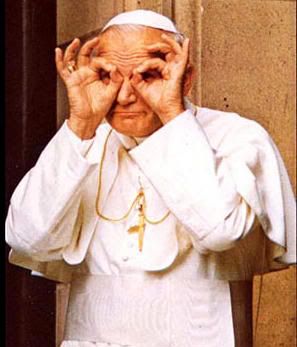Traditions of the Church

+Pope John Paul II (1920-2005)
(Photo from this site. It shows his ability to candidly reach out, specially to the youth, from behind his office's formality and stature.)
Pope John Paul II Dies at 84:
While we mourn the passing of Karol Wojtyla or Pope John Paul II to us 1.2 Billion Roman Catholics, we are now left with the question as to what shall happen to our Church's power structure. We are, after all, human - and that means we need to organize ourselves with the guidance of the Holy Spirit.
It is also interesting to observe the procedures that the Vatican shall be doing in the next few days. Personally, I have always found our traditions to be of great importance and significance.
News agencies report that the "Pope's Death Triggers [a] Scripted Ritual", a set of rites that have been observed by the Vatican everytime a pontiff dies, since ancient times. Recent modifications were made however by none other than the late John Paul II himself, when he released a 1996 document Universi Dominici Gregis (Of the Lord's Whole Flock) that specifically gives instructions on how Vatican officials are to move upon a Pope's death and how the subsequent voting for a new Pope shall proceed.
The news article Process of selecting a new pope is shrouded in secrecy describes very well how the Conclave of the College of Cardinals shall go about electing the new pontiff. Why it is called a conclave is explained by the following from another news article already cited above:
The Vatican voting process is very much shrouded in secrecy and sanctity. To give an illustration how it goes, here's a few lines from Universi Dominici Gregis, in particular how the ballot is to be placed in the receptacle (ballot box):
Until then, we wait in mourning, prayer, and contemplation.
In contrast to the church's ancient traditions, [Vatican Spokespan] Navarro-Valls announced the death to journalists in the most modern of communication forms, an e-mail that said: "The Holy Father died this evening at 9:37 p.m. in his private apartment." The spokesman said church officials were following instructions that John Paul had written for them on Feb. 22, 1996.May God find favor in his 26 years of spiritual leadership.
While we mourn the passing of Karol Wojtyla or Pope John Paul II to us 1.2 Billion Roman Catholics, we are now left with the question as to what shall happen to our Church's power structure. We are, after all, human - and that means we need to organize ourselves with the guidance of the Holy Spirit.
It is also interesting to observe the procedures that the Vatican shall be doing in the next few days. Personally, I have always found our traditions to be of great importance and significance.
News agencies report that the "Pope's Death Triggers [a] Scripted Ritual", a set of rites that have been observed by the Vatican everytime a pontiff dies, since ancient times. Recent modifications were made however by none other than the late John Paul II himself, when he released a 1996 document Universi Dominici Gregis (Of the Lord's Whole Flock) that specifically gives instructions on how Vatican officials are to move upon a Pope's death and how the subsequent voting for a new Pope shall proceed.
The news article Process of selecting a new pope is shrouded in secrecy describes very well how the Conclave of the College of Cardinals shall go about electing the new pontiff. Why it is called a conclave is explained by the following from another news article already cited above:
The word "conclave" comes from the Latin for "with a key," referring to a practice that arose in the 13th century.Drastic measures used in frustration? Perhaps. (Maybe we should have "conclaved" our Philippine legislators last May-June 2004 when they kept on delaying the counting of ballots in Congress.)
In 1243, the Senate and people of Rome broke a year-and-a-half deadlock by locking the cardinals up until they finally elected a new pope. In 1271, the cardinals were not only locked up, but were put on a diet of bread and water until they could agree.
The Vatican voting process is very much shrouded in secrecy and sanctity. To give an illustration how it goes, here's a few lines from Universi Dominici Gregis, in particular how the ballot is to be placed in the receptacle (ballot box):
Each Cardinal elector, in order of precedence, having completed and folded his ballot, holds it up so that it can be seen and carries it to the altar, at which the Scrutineers stand and upon which there is placed a receptacle, covered by a plate, for receiving the ballots. Having reached the altar, the Cardinal elector says aloud the words of the following oath: I call as my witness Christ the Lord who will be my judge, that my vote is given to the one who before God I think should be elected. He then places the ballot on the plate, with which he drops it into the receptacle. Having done this, he bows to the altar and returns to his place.The length of time for the Conclave depends on how long the Cardinals will take to choose the next Pope. After all has been said and done, the signs that we outside the Sistine Chapel should look for will include white smoke coming out of the Chapel's chimney, and the protodeacon (Chilean Cardinal Medina Estivez)'s proclamation "Habemus papam!" - which means "We have a pope!"
Until then, we wait in mourning, prayer, and contemplation.



0 Comments:
Post a Comment
<< Home